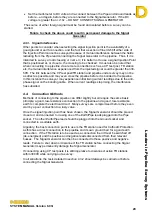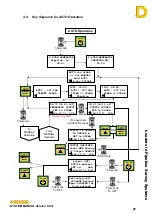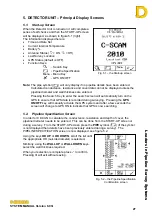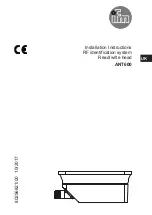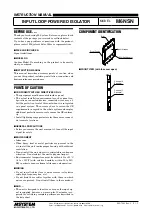
Leaders in Pipelin
e Survey Systems
C
C
C
-
-
-
S
S
S
C
C
C
A
A
A
N
N
N
2
2
2
0
0
0
1
1
1
0
0
0
SYSTEM MANUAL Version 6.03i
33
6.3.2. Planning
In planning a survey, particularly on a pipeline that has not been C-SCAN surveyed before,
it is helpful to reference survey point locations and signal injection locations that can be
marked on the map. Signal injection requires conductive electrical access to the pipeline
and must therefore be at CP Test Posts, TR Stations, or possibly block valves, insulation
joints, etc. When selecting these it should be remembered that the area in the immediate
vicinity of the signal input cannot be surveyed (approx 30-50 ft), thus if a particular road or
stream crossing is likely to be the site of faults, this requires that the Signal Generator is
NOT positioned at the CP Post alongside the road/stream but at the next one. The
surveyor should include some degree of overlap in the lengths of pipeline that are
surveyed from each Signal Generator position to ensure that the ‘dead spots’ are
adequately covered.
DO NOT survey across the generator as the results obtained will be meaningless
6.3.3. Common Fault Areas
The most common sites for wrap and coating defects are where the pipeline runs
underneath roadways and rivers or streams, where the pipe trench has been cut through
rock rather than soft sub-soil and where other excavations (for civil engineering work or
laying additional pipelines) have taken place close to the line of the pipe after it was
installed. Other areas to be checked include block valves, joints between sections
installed by different teams at different times, steep slopes, and areas where the pipeline
changes direction with a relatively small radius/bend. It is suggested that in these areas,
the survey points should be relatively close together.
6.3.4. Reference Readings
It may be desirable to compare absolute readings from one survey to the next – a
reference reading. If reference readings are considered necessary then these should be
taken at locations which must be identifiable and permanent, so that readings can be
exactly repeated at a later date to check for changes in coating dielectric performance.
This means that they should generally be at road crossings or field boundaries which can
be identified on a map and on the ground. The sites for reference readings will frequently
be dictated by the topography.
6.4. Survey Procedure
This section expands on the Survey Procedure Overview listed in 6.2.2 and guides the
surveyor through the process of locating, sampling and saving data points in order to carry
out a survey.
6.4.1. Signal Injection
Before a survey can begin, the pipeline under inspection needs to be connected to the
Signal Generator and the signal injected. Typical injection methods are given in section
4.3 with more advanced techniques discussed in section 8.6.
6.4.2. Locate Pipeline
If surveying from the Signal Generator it must be remembered that the first survey point
reading cannot be taken within 30-50 ft of the signal Injection Point due to ground
interference effects discussed in section 4.3.3. Using the SEARCH screen as discussed in
section 5.3 the surveyor should locate the pipeline under inspection and move the
Detector closer until the straight line crosses the centre of the circle and the distance to the
pipeline is zero (it is often easiest to approach the pipeline at right angles). Although the
Detector is now over the pipeline the surveyor needs to ensure he is ‘overhead’ before
taking any samples.


